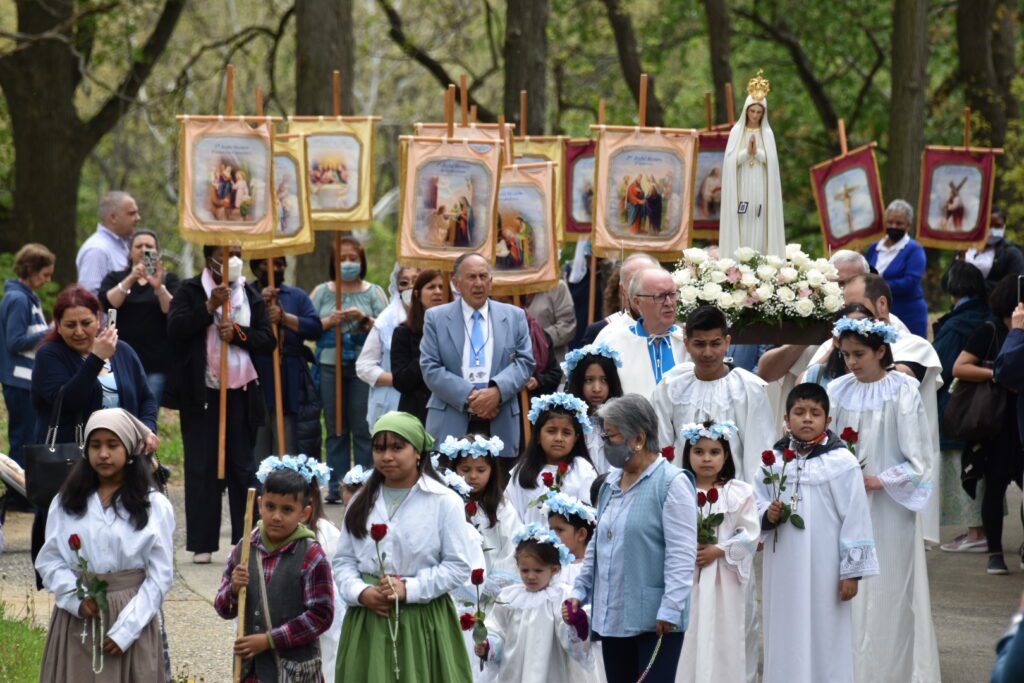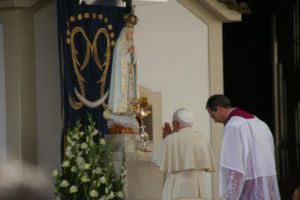by Father James L. P. Miara –


His Excellency Joao Pereira Venancio, who was bishop of the Diocese of Leiria-Fatima from 1958 – 1968, when asked to summarize the message of Fatima, said: “Fatima is reparation, reparation, reparation and especially Eucharistic reparation.”
Fatima is very Eucharistic. This is evident when one visits the sanctuary in Portugal, where all is centered on the Eucharist. There is the Chapel of Perpetual Adoration, where our Eucharistic Lord has been exposed in the monstrance and adored since 1960. There are several religious houses around the shrine whose apostolate is adoration of the Real Presence in their chapels. During the summer months, a procession of the Most Blessed Sacrament takes place in the precincts of the shrine on Sundays and Thursdays. Hundreds of thousands of Holy Masses have been offered at the Capelinha (Little Chapel of the Apparitions) since 1921, continuing all day, seven days a week. Masses also take place at the nearby Basilica of Our Lady of the Rosary.
Fatima begins with the Eucharist
In 1916, the Angel of Peace, whom many believe was St. Michael the Archangel, visited Lucia, Francisco and Jacinta to prepare them for Our Lady’s visit one year later. He told them to pray and to make reparation for sin. During his third and final apparition, he came holding a chalice and above it a Host from which drops of blood flowed into the chalice. Leaving the Host and chalice suspended, he prostrated himself with his forehead to the ground and repeated three times a prayer that has become known as the Angel’s Prayer: “O Most Holy Trinity, Father, Son and Holy Spirit, I adore You profoundly and I offer You the Most Precious Body, Blood, Soul and Divinity of Jesus Christ, present in all the tabernacles of the world, in reparation for the outrages, sacrileges and indifference by which He is offended. By the infinite merits of His Most Sacred Heart and the Immaculate Heart of Mary, I beg the conversion of poor sinners.”


Then the angel rose and gave the Host to Lucia and the contents of the chalice to Jacinta and Francisco, saying at the same time, “Take and drink the Body and Blood of Jesus Christ, horribly outraged by ungrateful men. Repair their crimes and console your God.” This was the First Holy Communion for Francisco and Jacinta. The three made their thanksgiving after Holy Communion by prostrating with the angel and again repeating the “Angel’s Prayer” before he departed.
Fatima ends with the Eucharist
Fatima ends with the Eucharist with the so-called Last Vision, which Sister Lucia saw in the chapel of the Dorothean convent on June 13, 1929. This Eucharistic vision, a vision of the Most Holy Trinity, summarizes the Fatima message and shows how all the basics of the holy Catholic faith are connected to the Eucharist. (See sidebar)
Some of the happenings at Fatima between these two great events are directly connected with the Eucharist.
Our Lady’s apparitions at Fatima began on May 13, which is the feast of Our Lady of the Most Blessed Sacrament. After asking the three seers if they would offer themselves to God and bear all the sufferings He would send them, and receiving their “yes,” she said they would have much to suffer, but God’s grace would strengthen them. Then she opened her hands and radiated a light so intense, the children understood the light was God. Sister Lucia wrote: “We could see ourselves embraced in it. By an interior impulse of grace, we fell to our knees, repeating in our hearts: “Oh, Most Holy Trinity, I adore You. My God, my God, I love You in the Most Blessed Sacrament.” This has become known as the Eucharistic prayer. During the July apparition, Our Lady told the three shepherds that she would come to ask for the First Saturday Communions of Reparation, which she did on Dec. 10, 1925, while Sister Lucia was living at the Dorothean convent in Pontevedra. Thus was born the five First Saturday devotion, the heart of this devotion being offering one’s Holy Communion on that day in reparation to the Immaculate Heart of Mary.
The last Eucharistic element of the Fatima apparitions occurred on October 13, when Our Lady asked that a chapel be built in her honor at the exact spot where she appeared in the Cova da Iria. A chapel is used primarily to offer the Holy Sacrifice of the Mass and to have a dignified place in which to reserve the Blessed Sacrament for adoration.
After the events of 1917, the children were changed. They loved to hear Holy Mass and desired to receive Jesus in Holy Communion. Francisco knew that his time on earth was short and so would spend a good part of his day in the parish church adoring the “Hidden Jesus” in the tabernacle. He devoutly received Holy Communion for the last time on his deathbed, going into ecstasy when Jesus was placed on his tongue.
Jacinta begged to receive Holy Communion when she was dying, but the priest delayed his visit thinking she would survive the night. She spent hours with our Eucharistic Lord in the chapel at the orphanage in Ourem, where she convalesced. She lamented often, “How disrespectful people are to Our Lord when they are in church. Our Lady is displeased if people do not show proper respect to the Blessed Sacrament.”
Many believe the promised triumph of the Immaculate Heart of Mary will be a Eucharistic one. As devotees of Our Lady of Fatima, let us make reparation to the Most Blessed Sacrament and console our Lord for all of the blasphemies, sacrileges and indifferences committed against Him. We can repair for these offences by making visits to the Blessed Sacrament, praying Eucharistic Holy Hours and all-night vigils, making Spiritual Communions and attending Holy Mass devoutly as often as we can.
[SIDEBAR] The Last Vision
Sister Lucia described in her memoirs: “Suddenly the whole chapel was illuminated by a supernatural light, and a cross of light appeared above the altar, reaching to the ceiling. In a bright light at the upper part of the cross could be seen the face of a man and his body to the waist (Father) on his breast there was a dove also of light (Holy Spirit) and, nailed to the cross, was the body of another man (Son). Somewhat above the waist, I could see a chalice and a large host suspended in the air, on to which drops of blood were falling from the face of Jesus Crucified and from the wound in His side. These drops ran down on to the host and fell into the chalice. Our Lady was beneath the right arm of the cross (…it was Our Lady of Fatima with her Immaculate Heart…in her left hand…with a crown of thorns and flames…) Under the left arm of the cross, large letters, as of crystal-clear water which ran down over the altar, formed these words: Graces and Mercy. I understood that it was the mystery of the Most Holy Trinity that was shown to me. Our Lady then said to me: ‘The moment has come when God asks the Holy Father, in union with all the bishops of the world, to make the Consecration of Russia to my Heart, promising to save it by this means.’”












